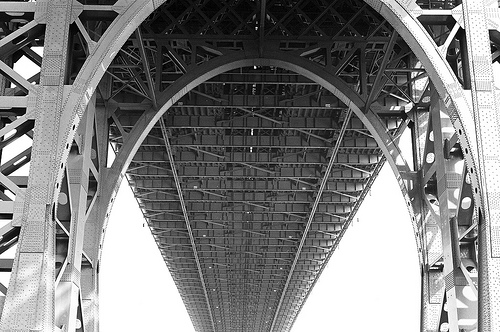October 25, 1903. Up until about 4 p.m. on that listless Sunday, the only topic of interest had been the weather. The first chill of autumn had fallen, and everyone strolling the Brooklyn shore that day sought out their own little place in the sun.
But suddenly all complacency ended when a flash-mob of children burst on the scene. In a split-second they were all over the place, incited by none other than one of their own, a street urchin calling from the foot of the docks. He yodeled a series of “melodious yelps,” the eternal high sign, common to all kids, that something was up. And so, crazy with delight, laughing and screaming, the little ones invaded the East River piers.
This extraordinary commotion drew the attention of hundreds. They pressed forward, en masse, to behold what had amazed their children that hour: the sight of two people, a young lady and her escort, ascending one of the cables of the Williamsburg Bridge.
It was a full two months before the bridge was to open. The giant span was still festooned with the catwalks the crew had used to tighten the wires. One of these contrivances is what beckoned the dare-devils to steal aboard. But what a treacherous route to heaven it was — nothing but slats, 20 inches wide. A few unlucky workers had already fallen from these catwalks. Would the young woman and this man soon join them in death?
The watchman on duty assured a reporter from The Times that the lady in question was “a good-looker,” as if to explain just how she got past him. She had on a snug tan jacket, a fashionable hat, and a long black skirt, “which was whipped like a flag in the strong breeze.”
By now, the crowd traversing the Brooklyn Bridge had noticed the girl and hailed her from the rail. Ferry passengers churning upriver also cheered her ecstatically as they crowded the bow. In response, from 300 feet in the air, the young lady waved and gave them a smile. Her companion then hoisted her up on top of the tower, and together they paused to admire the sun and the sea.
Why did they do it? Was it some kind of love pact? Was it his idea? Her idea? Whatever the answer, when they finally inched their way down, an ovation swelled from the Brooklyn Bridge and both shores of the river. And once they were safe on the pedestrian walkway, they rushed across to Manhattan, where, with no one to stop them, they disappeared into the “swarming” Lower East Side.
“I felt like a giant,” a neighbor of mine told me as she confessed to a similar feat back in the 90’s. One night, on the invitation of a notorious bridge-climber, she found herself walking up the cable to the top of the Manhattan-side stanchion of the Brooklyn Bridge. Such a feat would be quite impossible now, given our constant state of alert, but she betrayed no qualms. “It was like walking on air,” she said. Once at the top, from that bizarre perspective, she and her friend marveled at the glittering, toy-like city below.
Bridges seem to invite this sort of behavior, and the Williamsburg is no exception. But since climbing is altogether forbidden, why not just walk across them instead? The experience is still unforgettable. What a frenzy of steel surrounds you, much like the Eiffel Tower in Paris. Its enormity, too, reminds one of the ill-fated Titanic, whose construction followed it only nine years later. Titanic-like too are the ribs of interior girders, which resemble the keel of a magic vessel in a Jules Verne adventure.
Now look up. The twin-headed towers: aren’t they colossal? And the giant cables: doesn’t their swoop make you dizzy? And then there’s the vivid, spectacular view: the metropolis, and the world beyond. To see all this through the eyes of the girl in the sky perhaps raises the bridge to the status of myth.
But we still come back to the question of why.
The answer must lie in the bridge itself. The Williamsburg was born of a dream. It was not a luxury condo or haughty development, nor a stadium for supermen. This tremendous, gargantuan thing made of steel became, in its day, inspiration itself.
The young woman who climbed it understood that, I think, when she had an idea to make it her own.
Thanks to Elinor Nauen for her help in preparing this post.





